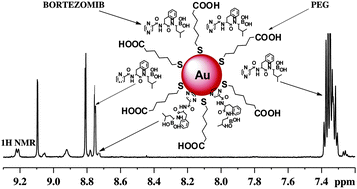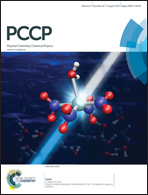Structural characterization of functionalized gold nanoparticles for drug delivery in cancer therapy: a NMR based approach
Abstract
In the present paper, we report results from a study of the structure and physicochemical properties of gold nanoparticles modified with poly(ethylene glycol) (PEG) designed for the drug delivery of the proteasome inhibitor Bortezomib (BTZ) in cancer therapy. A number of advanced analytical techniques were used to define important physicochemical characteristics such as composition, structure, surface properties, particle size and morphology. A new approach based on detailed NMR studies was employed to define specific intermolecular interactions and mechanisms of drug immobilization and location into surface modified gold nanoparticles (AuNPs). Particularly important information was gained from analysis of NMR spectroscopic parameters such as the spectral line shape, translation diffusion, the nuclear Overhauser effect (NOE) and spin–lattice relaxation (T1). The results confirmed the coexistence of two different types of BTZ inclusion into polyethylene glycol coated gold nanoparticles: (i) association with the polymer chains by weak H-bonds and/or dipole–charge interactions and (ii) adsorption on the surface of the gold nanoparticles. The results allowed for determination of the overall structure of Bortezomib loaded PEG coated AuNPs, which is related to the therapeutic drug efficacy and activity in the treatment of cancer.


 Please wait while we load your content...
Please wait while we load your content...